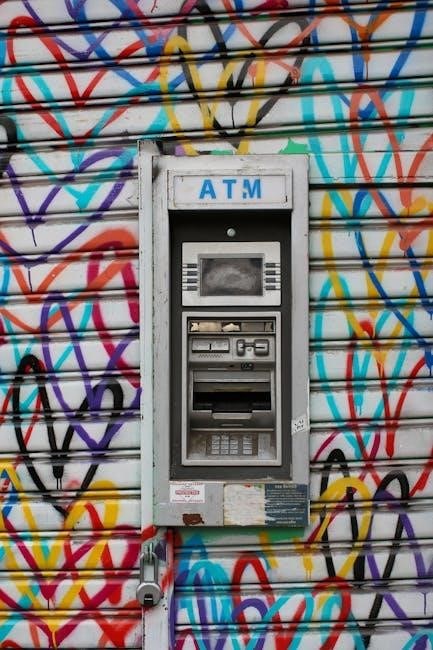Lyn Alden’s “Broken Money” explores the evolution of money‚ tracing its journey from ancient commodities to modern fiat systems‚ emphasizing technology’s role in shaping monetary systems.
1.1 Overview of Lyn Alden’s Book
Lyn Alden’s “Broken Money” provides a panoramic view of money’s history‚ from early commodity-backed systems to modern fiat currency. The book explores how technology has shaped monetary systems‚ offering insights into the transition from shells and gold to digital currencies like Bitcoin. Alden’s comprehensive approach bridges the past‚ present‚ and future of money‚ making it accessible for readers of all financial knowledge levels.
1.2 Key Themes and Objectives
Lyn Alden’s Broken Money examines the flaws in the current financial system‚ emphasizing the transition from commodity-backed currencies to fiat money. The book highlights how technology drives monetary evolution and explores the challenges of central banking. Its objective is to empower readers with a deep understanding of money’s history‚ theoretical foundations‚ and practical implications‚ enabling informed decisions in a rapidly changing financial world.

The Evolution of Money
The evolution of money traces from primitive barter systems to complex digital currencies‚ driven by technological advancements and societal needs for efficient exchange and value storage.
2.1 From Shells to Gold: Early Forms of Currency
Early forms of currency‚ such as shells‚ beads‚ and precious metals‚ emerged as societies sought standardized mediums of exchange. These commodities‚ valued for their rarity and durability‚ laid the foundation for modern monetary systems‚ highlighting the transition from informal barter to more structured economic transactions.
2.2 The Role of Technology in Shaping Monetary Systems
Technology has revolutionized monetary systems‚ from the telegraph enabling global communication to Bitcoin’s decentralized ledger. These innovations transformed how value is transferred‚ stored‚ and verified‚ reducing reliance on physical currencies and intermediaries while enhancing efficiency and accessibility in financial transactions.

The Ledger as the Foundation of Money
Ledgers form the backbone of monetary systems‚ enabling secure and efficient tracking of transactions and ownership‚ a concept central to Lyn Alden’s analysis.
3.1 The Concept of Ledgers in Financial Transactions
Lyn Alden explains that ledgers are fundamental to financial transactions‚ serving as records of ownership and exchanges. They provide transparency and trust‚ forming the basis of all monetary systems‚ from ancient trade to modern digital currencies.
3.2 Historical Examples of Ledger Systems
Alden highlights historical ledger systems‚ such as ancient Mesopotamia’s clay tablets and medieval Europe’s tally sticks‚ demonstrating how these early tools tracked transactions and facilitated trade. These systems laid the groundwork for modern financial record-keeping‚ showcasing the enduring importance of ledgers in economic history.
Commodities as Money
Lyn Alden examines how tangible assets like gold historically served as money‚ transitioning to fiat currency‚ and the implications of this shift on economic value and stability.
4.1 The Transition from Commodities to Fiat Currency
Lyn Alden details how societies shifted from commodity-backed money‚ like gold‚ to fiat systems‚ driven by technological advancements and political needs. This transition introduced both efficiency and instability‚ as fiat currencies rely on trust in governing institutions rather than tangible value‚ fundamentally altering global economic dynamics and monetary policy frameworks.
4.2 The Role of Gold in the Global Monetary System
Gold historically emerged as a dominant commodity currency due to its scarcity and durability‚ serving as a reliable store of value. Lyn Alden highlights how gold’s properties made it a natural choice for monetary systems‚ providing stability across civilizations. Its role evolved alongside fiat systems‚ but gold remains a hedge against inflation and a symbol of financial resilience in uncertain economic times.

The Unified Theory of Money
Lyn Alden’s unified theory of money presents a comprehensive framework‚ integrating commodity‚ fiat‚ and technological currencies‚ to explain the evolution of monetary systems cohesively.
5.1 Lyn Alden’s Perspective on Monetary Theory
Lyn Alden’s perspective on monetary theory emphasizes technology’s role in shaping currency‚ arguing that ledgers‚ not physical objects‚ are money’s true foundation; She traces this evolution from early commodity-based systems to modern digital innovations‚ highlighting how each advancement reflects humanity’s need for efficient record-keeping and value transfer‚ ultimately reshaping global economics and financial systems.
5.2 Practical Implications of the Theory
Lyn Alden’s theory underscores the flaws in the fiat currency system‚ particularly its impact on developing nations and wealth inequality. She advocates for understanding these dynamics to navigate modern finance effectively‚ emphasizing strategic investments in assets like gold and Bitcoin to hedge against systemic risks and create a resilient financial strategy in an uncertain economic landscape.
The Birth of Banking
Lyn Alden traces banking’s origins to proto-banking systems‚ such as the Hawala network‚ highlighting how early financial systems relied on trust and informal ledger practices.
6.1 Proto-Banking and the Hawala System
Lyn Alden examines proto-banking systems‚ such as the Hawala network‚ which relied on trust and informal ledgers to facilitate transactions without physical currency. These early systems demonstrate how financial intermediation evolved‚ laying the groundwork for modern banking by emphasizing trust‚ record-keeping‚ and the transfer of value across distances without formal institutional frameworks.
6.2 The Evolution of Banking Institutions
Lyn Alden traces the transformation of banking from informal networks to formal institutions‚ highlighting how central banks emerged to standardize monetary practices. She explores how technological advancements‚ such as the telegraph‚ enhanced banking efficiency and connectivity‚ enabling global financial systems to expand and integrate‚ while addressing the challenges of centralized control and systemic risks.

Central Banks and Their Impact
Lyn Alden examines how central banks gained control over money‚ addressing the balance between preventing systemic collapse and maintaining trust in fiat systems globally.
7.1 The Rise of Central Banks
Central banks emerged as pivotal institutions‚ centralizing monetary control and stabilizing economies. Lyn Alden highlights their historical rise‚ from early proto-banking systems to modern entities managing currency and financial stability‚ influencing global economic structures and policy frameworks significantly‚ as detailed in “Broken Money.”
7.2 Challenges and Criticisms of Central Banking
Central banking faces criticism for concentrating financial power and enabling systemic inequality. Lyn Alden argues that central banks‚ while stabilizing economies‚ often prioritize institutional interests over public welfare. The fiat system’s flaws‚ such as inflation and debt cycles‚ highlight vulnerabilities. Critics contend that central banking’s disconnect from tangible assets and its role in wealth redistribution exacerbate financial instability globally.

The Fiat Currency System
Lyn Alden examines the fiat currency system‚ highlighting its detachment from tangible assets and reliance on government decree. She discusses its historical rise and inherent vulnerabilities.
8.1 The Flaws of the Fiat Standard
Lyn Alden details the fiat standard’s flaws‚ including its susceptibility to inflation‚ central bank overreach‚ and wealth inequality. She argues that without commodity backing‚ fiat currencies risk devaluation‚ undermining trust in monetary systems‚ particularly affecting developing nations reliant on unstable exchange rates. This instability fosters economic disparities‚ highlighting the need for systemic reform.
8.2 Effects on Developing Nations
Lyn Alden highlights how the fiat standard disproportionately impacts developing nations‚ exacerbating poverty and inequality. Without a stable monetary anchor‚ these countries face volatile exchange rates‚ inflation‚ and reduced purchasing power. This instability hinders economic growth‚ traps nations in debt cycles‚ and limits access to global markets‚ deepening systemic disparities in the global financial system.
The Role of Technology in Modern Finance
Technology revolutionizes finance‚ from the telegraph enabling global communication to Bitcoin introducing decentralized systems‚ reshaping how money moves and is perceived across the world.
9.1 The Invention of the Telegraph and Its Impact
The telegraph revolutionized finance by enabling rapid communication‚ facilitating global trade‚ and standardizing financial transactions. It laid the groundwork for modern financial systems by connecting markets worldwide‚ allowing real-time information exchange‚ and fostering economic integration. This technological breakthrough was pivotal in shaping the global economy‚ as highlighted in Lyn Alden’s analysis of money’s evolution in Broken Money.
9.2 Bitcoin and the Future of Money
Bitcoin emerges as a revolutionary force in Lyn Alden’s analysis‚ offering a decentralized alternative to traditional fiat systems. By leveraging blockchain technology‚ Bitcoin introduces a secure‚ transparent‚ and efficient method of transactions‚ potentially transforming the global monetary landscape. Alden explores how this innovation could address flaws in the current system‚ reshaping the future of money and finance.

The Future of Money
The future of money lies in innovation‚ with technologies like blockchain and decentralized systems reshaping traditional financial frameworks‚ offering solutions to current monetary system flaws.
10.1 Potential Innovations and Trends
Lyn Alden highlights emerging technologies like blockchain and decentralized finance (DeFi) as transformative forces. These innovations promise enhanced security‚ transparency‚ and efficiency in financial systems. The rise of digital currencies and smart contracts could revolutionize traditional payment methods‚ offering faster and more accessible solutions. Such trends may empower individuals and businesses‚ fostering a more equitable and resilient global economy.
10.2 The Intersection of Technology and Finance
The integration of technology and finance has revolutionized monetary systems. From the telegraph enabling rapid transactions to Bitcoin’s decentralized ledger‚ innovation continues to reshape global economics; These advancements enhance efficiency‚ reduce barriers‚ and promote financial inclusion‚ creating a more interconnected and accessible monetary landscape for individuals and institutions worldwide.

Practical Implications for Investors
Lyn Alden’s “Broken Money” provides investors with a roadmap to understand the financial landscape‚ offering insights to make informed decisions and strategically invest in a changing economy.
11.1 Understanding the Financial Landscape
Lyn Alden’s “Broken Money” provides a detailed analysis of the financial system‚ highlighting the transition from commodity-based currencies to fiat money and the role of central banks. She emphasizes how technology has reshaped monetary systems‚ offering insights into the current economic framework and its implications for investors seeking to navigate an increasingly complex global financial landscape effectively.
11.2 Strategic Investment in a Broken System
Lyn Alden’s “Broken Money” equips investors with strategies to navigate the flawed financial system. By understanding the historical evolution of money and the role of technology‚ readers can make informed decisions. Diversification‚ awareness of monetary policy‚ and leveraging emerging technologies like Bitcoin are key to building resilience in an uncertain economic landscape shaped by the fiat standard’s vulnerabilities.
Lyn Alden’s “Broken Money” concludes with a comprehensive analysis of money’s evolution‚ emphasizing technology’s enduring impact and the need for a resilient financial system adaptable to future challenges.
12.1 Summary of Key Insights
Lyn Alden’s “Broken Money” provides a detailed exploration of money’s evolution‚ from ancient commodities to modern fiat systems. It highlights technology’s pivotal role in shaping monetary systems‚ the flaws of the fiat standard‚ and the importance of understanding these dynamics for informed financial decisions in an increasingly complex global economy.
12.2 The Significance of “Broken Money” in Modern Finance
Lyn Alden’s “Broken Money” offers a comprehensive analysis of the financial system‚ highlighting its flaws and the impact of technology. By tracing money’s evolution‚ the book provides insights into the challenges of fiat currency and the role of innovation. It serves as a vital resource for understanding modern finance‚ empowering readers to navigate its complexities and anticipate future trends.

Additional Resources
Find “Broken Money” in PDF format on Amazon or Lyn Alden’s official website. Explore related books like “The Bitcoin Standard” for deeper insights into monetary systems.
13.1 Where to Find the “Broken Money” PDF
The “Broken Money” PDF can be found on Amazon‚ alongside hardcover‚ paperback‚ and audiobook formats. Lyn Alden’s official website also offers direct access to the book. Additionally‚ online platforms like Audible provide the audiobook version for convenient listening. The PDF is widely available‚ making it easily accessible for readers interested in exploring Alden’s insights on monetary systems and financial strategies.
13.2 Related Reading and Further Research
For deeper insights‚ explore works like Nick Szabo’s “Shelling Out” and George S. Clason’s “The Richest Man in Babylon.” These texts complement Lyn Alden’s perspectives on monetary history and financial strategies. Additional resources‚ including interviews and podcasts featuring Lyn Alden‚ can be found on platforms like Amazon‚ Audible‚ and her official website‚ offering a comprehensive understanding of monetary systems and trends.